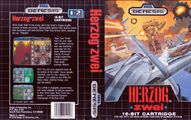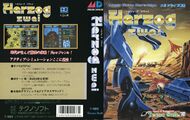Difference between revisions of "Herzog Zwei"
From Sega Retro
| Line 67: | Line 67: | ||
| megatech_source={{num|1|page=78|pdf=Megatech UK 01.pdf|pdfpage=78}} | | megatech_source={{num|1|page=78|pdf=Megatech UK 01.pdf|pdfpage=78}} | ||
| playtime=85 | | playtime=85 | ||
| − | | playtime_source=''[http://www. | + | | playtime_source=''6/91, [http://translate.google.co.uk/translate?sl=de&tl=en&u=http://www.ninretro.de/game-4-2397.html p116/117]'' |
| pp=80 | | pp=80 | ||
| + | | pp_source=''4/90, [http://www.kultpower.de/powerplay_testbericht_extern.php3?im=herzog2.jpg p121]'' | ||
| raze=80 | | raze=80 | ||
| raze_source={{num|5|page=58/59}} | | raze_source={{num|5|page=58/59}} | ||
Revision as of 10:47, 19 June 2015
| Herzog Zwei | |||||
|---|---|---|---|---|---|
| System(s): Sega Mega Drive | |||||
| Publisher: Technosoft | |||||
| Developer: Technosoft | |||||
| Genre: Simulation | |||||
| Number of players: 1-2 | |||||
|
Herzog Zwei (ヘルツォーク・ツヴァイ) is the sequel to Herzog, and was released exclusively for the Sega Mega Drive in 1989.
Herzog Zwei is often credited for creating the foundations of the real time strategy genre. The player controls a unit which can freely transform from a plane to a robot, and must create and transport units to capture structures and destroy enemy bases.
Overview
Herzog Zwei (ヘルツォーク・ツヴァイ| Herutsuōku Tsuvuai) (German: Herzog Zwei "Duke Two") is a real-time strategy video game developed by Technosoft for the Sega Mega Drive/Genesis home console. It was published in Japan by Technosoft in 1989 and in North America and Europe by Sega in early 1990.[1][2] It is the sequel to Herzog, which was released only in Japan for the MSX and PC-8801 personal computers in 1988.
Herzog Zwei combined the fully real-time, fast-paced, arcade-style action gameplay of Technosoft's own Thunder Force series with a fairly easy-to-grasp level of strategy gameplay. [1][2][3] It differed significantly from both turn-based strategy and real-time tactics, [3] and is the earliest example of a game with a feature set that falls under the contemporary definition of modern real-time strategy. [4][4] Along with a single-player mode against a computer opponent, it featured a split-screen two-player mode where both players are in action simultaneously and there are no pauses while decisions are taken, forcing players to think quickly while on the move.[3] Though the player only controls one unit, a transforming mech, the manner of control foreshadowed the point-and-click mechanic of later games. It introduced much of the genre conventions, including unit construction and resource management, with the control and destruction of bases being an important aspect of the game, as were the economic/production aspects of those bases. [5]
Upon release, the game received little mainstream recognition, and its novel approach to strategy gameplay polarized critics who were uncertain about what to make of it.[5] [6] It was generally well received by Japanese [7] and European critics,[6] with Computer and Video Games recognizing that its fully real-time, fast-paced gameplay set it apart from other strategy games at the time,[3] while The Games Machine found its mixture of strategy and shoot 'em up elements to be unusual but refreshing.[2] Reactions from North American critics, however, were generally negative,[5] with Electronic Gaming Monthly criticizing it for being too complex, judging it as a flawed shooter rather than a novel strategy game, [8] and giving it some of its lowest review scores for a Genesis game.[5]
Years after its release, the game eventually gained a cult following. [9] It has since been considered one of the best two-player Mega Drive/Genesis games, and has been listed among the best games of all time, by Electronic Gaming Monthly,[7][8] IGN[9][10] and Next Generation. [10] It has been credited with laying the foundations for the real-time strategy (RTS) genre, [11][4][11] predating and influencing the genre-popularizing Dune II.[12][13] It is also retrospectively considered a precursor to the multiplayer online battle arena (MOBA) genre, which uses a similar formula of each player controlling a single command unit in one of two opposing sides on a battlefield.[14][15][16] Herzog Zwei has been listed as one of the most important games ever made by 1UP, [12] while GameSpy listed it as one of the most underrated games of all time.[17]
Production Credits
- Main Program: Takashi Iwanaga
- Weapon Program: Haruhiko Ohtsuka
- Map Design: Osamu Tsujikawa
- Character Design: Izumi Fukuda
- Demo Program: Izumi Fukuda
- Music Compose: Naosuke Arai, Tomomi Ohtani
- Sound Effect: Naosuke Arai, Tomomi Ohtani
- Manual Writer:Fumio Sugano
- Herzog: T. O.
- Special Thanks: Marie Hughes, Kamometei
- Copyright: Tecno Soft
Physical Scans
| 70 | |
|---|---|
| Based on 31 reviews | |
| Mega Drive, CA |
|---|
|
- ↑ http://www.gamefaqs.com/genesis/473001-herzog-zwei/data
- ↑ 2.0 2.1 http://amr.abime.net/review_23961
- ↑ 3.0 3.1 3.2 http://amr.abime.net/review_27759
- ↑ 4.0 4.1 http://gamespy-archives.quaddicted.com/sites/www.strategyplanet.com/features/articles/strategypeak/index.html
- ↑ 5.0 5.1 5.2 http://www.sega-16.com/2005/07/herzog-zwei/
- ↑ http://segaretro.org/Herzog_Zwei#Physical_Scans
- ↑ http://kisrael.com/vgames/powerlist/egm100.html
- ↑ http://kisrael.com/vgames/powerlist/
- ↑ http://top100.ign.com/2003/61-70.html#62
- ↑ http://top100.ign.com/2005/091-100.html
- ↑ http://gamespot.com/gamespot/features/all/real_time/ (Wayback Machine: 2011-04-27 05:26)
- ↑ http://www.above-the-garage.com/blog/1998/8/18/the-origin-of-realtime-strategy-games-on-the-pc
- ↑ http://www.edge-online.com/features/the-making-of-dune-ii/
- ↑ http://www.destructoid.com/review-airmech-242461.phtml
- ↑ http://www.mcvuk.com/news/read/moba-the-story-so-far/0133335
- ↑ http://www.gamesradar.com/ask-gr-anything-whats-moba/
- ↑ http://archive.gamespy.com/articles/september03/25underrated/index19.shtml
- ↑ File:Megatech UK 01.pdf, page 78
- ↑ File:Segapro UK 03.pdf, page 61
- ↑ 1700 igr dlya Sega, "" (RU; 2001-xx-xx), page 95
- ↑ Aktueller Software Markt, "Avril 1990" (DE; 1990-03-30), page 78
- ↑ Beep! MegaDrive, "February 1990" (JP; 1990-01-08), page 69
- ↑ Complete Guide to Consoles, "Volume IV" (UK; 1990-11-xx), page 31
- ↑ Console XS, "June/July 1992" (UK; 1992-04-23), page 130
- ↑ Cool Gamer, "9" (RU; 2002-10-13), page 102
- ↑ Computer & Video Games, "April 1990" (UK; 1990-03-16), page 103
- ↑ Electronic Gaming Monthly, "May 1990" (US; 1990-xx-xx), page 20
- ↑ Entsiklopediya luchshikh igr Sega. Vypusk 1, "" (RU; 1999-xx-xx), page 321
- ↑ Entsiklopediya luchshikh igr Sega. Vypusk 3, "" (RU; 2000-xx-xx), page 107
- ↑ Famitsu, "" (JP; 1989-xx-xx), page 1
- ↑ The Games Machine, "March 1990" (UK; 1990-02-08), page 50
- ↑ Game Informer, "May 1999" (US; 1999-0x-xx), page 72
- ↑ Igry Sega Luchshiye iz luchshikh. Vypusk 2, "" (RU; 2001-08-27), page 207
- ↑ Joystick, "Novembre 1990" (FR; 1990-1x-xx), page 102
- ↑ Sega Mega Drive Advanced Gaming, "January 1993" (UK; 199x-xx-xx), page 63
- ↑ Mega Drive Fan, "May 1990" (JP; 1990-04-07), page 89
- ↑ Mega, "June 1993" (UK; 1993-05-20), page 20
- ↑ Mega, "August 1994" (UK; 1994-07-21), page 79
- ↑ MegaTech, "Xmas 1991" (UK; 1991-12-06), page 78
- ↑ Mean Machines Sega, "October 1992" (UK; 1992-09-xx), page 139
- ↑ Play Time, "6/91" (DE; 1991-05-10), page 116
- ↑ Power Play, "4/90" (DE; 1990-03-16), page 123
- ↑ Raze, "March 1991" (UK; 1991-01-31), page 58
- ↑ Sega Power, "July 1991" (UK; 1991-06-06), page 26
- ↑ Sega Power, "October 1991" (UK; 1991-09-05), page 53
- ↑ Sega Pro, "Christmas 1991" (UK; 1991-12-12), page 61
- ↑ Sega Pro, "April 1993" (UK; 1993-03-11), page 66
- ↑ Sega Saturn Magazine, "September 1995" (JP; 1995-08-08), page 85
- ↑ Tricks 16 bit, "Tricks Sega Gold 800 igr" (RU; 1998-03-20), page 16
- ↑ User, "Noémvrios 1990" (GR; 1990-1x-xx), page 63
- 1-2 player games
- Use romtable template
- All games
- Bad external reference
- Old-style rating (cgtc)
- Rating without PDF source
- Old-style rating (cvg)
- Old-style rating (gamesmachineuk)
- Old-style rating (joystick)
- Old-style rating (mdag)
- Old-style rating (mega)
- Old-style rating (megatech)
- Use magref
- Old-style rating (playtime)
- External rating reference
- Old-style rating (pp)
- Old-style rating (raze)
- Old-style rating (segapower)
- Old-style rating (segapro)
- Update ratings template
- 14 old ratings



